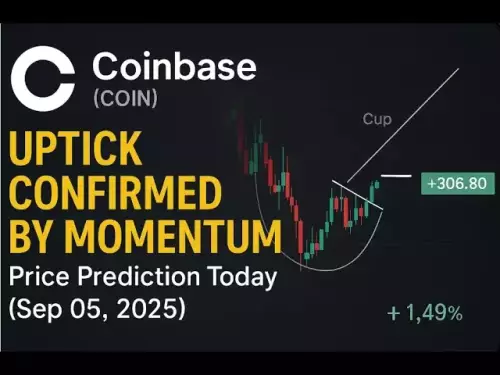-
 Bitcoin
Bitcoin $112700
2.05% -
 Ethereum
Ethereum $4378
0.17% -
 XRP
XRP $2.835
0.57% -
 Tether USDt
Tether USDt $1.000
-0.03% -
 BNB
BNB $849.2
0.17% -
 Solana
Solana $206.8
-0.07% -
 USDC
USDC $0.0000
-0.02% -
 Dogecoin
Dogecoin $0.2165
0.77% -
 TRON
TRON $0.3368
-0.42% -
 Cardano
Cardano $0.8258
1.04% -
 Chainlink
Chainlink $22.85
-1.92% -
 Hyperliquid
Hyperliquid $46.13
1.64% -
 Ethena USDe
Ethena USDe $1.001
-0.01% -
 Sui
Sui $3.387
2.62% -
 Bitcoin Cash
Bitcoin Cash $598.5
2.10% -
 Stellar
Stellar $0.3625
1.17% -
 Avalanche
Avalanche $24.68
-0.03% -
 Hedera
Hedera $0.2177
1.22% -
 Cronos
Cronos $0.2685
-0.09% -
 UNUS SED LEO
UNUS SED LEO $9.547
0.29% -
 Litecoin
Litecoin $112.5
1.10% -
 Toncoin
Toncoin $3.125
-1.36% -
 Shiba Inu
Shiba Inu $0.00001227
0.54% -
 Polkadot
Polkadot $3.822
1.19% -
 Uniswap
Uniswap $9.521
0.91% -
 Dai
Dai $1.000
0.01% -
 Monero
Monero $269.6
1.63% -
 Aave
Aave $311.5
-2.32% -
 Ethena
Ethena $0.6675
-5.00% -
 World Liberty Financial
World Liberty Financial $0.1844
2.34%
What is a "dead cat bounce" in trading?
A "dead cat bounce" is a brief, misleading recovery in price after a steep decline, often trapping traders who mistake it for a real reversal.
Sep 04, 2025 at 12:00 am

Understanding the Concept of a Dead Cat Bounce
1. A 'dead cat bounce' is a slang term used in financial markets, including the cryptocurrency space, to describe a temporary recovery in the price of an asset after a prolonged decline. This short-lived rally often misleads traders into believing that the downtrend has reversed, when in reality, the downward momentum soon resumes.
2. The phrase originates from the idea that even a dead cat will bounce if it falls from a great height, implying that any asset, no matter how fundamentally weak, can experience a minor rebound due to technical factors or short-covering, despite being in a long-term bearish trend.
3. In the context of cryptocurrency trading, this phenomenon is frequently observed during bear markets. After a major crash—such as those seen following the peaks of Bitcoin in 2018 or 2022—prices may briefly stabilize or rise slightly, prompting speculation of a recovery.
4. These short rallies often occur on low volume and lack strong fundamental backing. They are typically fueled by emotional trading, short-term speculation, or automated trading bots reacting to oversold conditions rather than genuine market strength.
5. Traders who mistake a dead cat bounce for a real trend reversal may enter long positions too early, only to face further losses when the downtrend accelerates again. This highlights the importance of distinguishing between temporary price fluctuations and sustainable market reversals.
Identifying a Dead Cat Bounce in Crypto Markets
1. One of the key indicators of a dead cat bounce is a sharp price drop followed by a small, short-lived increase in value. This rebound usually fails to reclaim significant resistance levels or prior support zones that were broken during the initial decline.
2. Volume analysis plays a crucial role. A genuine recovery is typically accompanied by rising trading volume, signaling strong buyer interest. In contrast, a dead cat bounce often occurs on diminishing or inconsistent volume, suggesting weak market participation.
3. Technical indicators such as the Relative Strength Index (RSI) may show that an asset is oversold, which can trigger a mechanical bounce. However, if the RSI fails to move into neutral or bullish territory and quickly turns downward again, it reinforces the likelihood of a false recovery.
4. Candlestick patterns can also provide clues. For example, a few green candles following a steep red cascade might look promising, but if they are small-bodied with long wicks, they indicate indecision and potential rejection at higher prices.
5. Market sentiment and on-chain data further support identification. If whale movements, exchange inflows, or funding rates continue to reflect bearish behavior, any price increase is more likely a trap than a turnaround.
Risks and Trading Strategies Around False Recoveries
1. Entering a long position during a suspected dead cat bounce can lead to significant drawdowns, especially in leveraged trading. Liquidations often spike when prices reverse sharply after such bounces, amplifying losses across the market.
2. Traders should avoid chasing price increases that lack confirmation from volume, momentum, and broader market context. Instead, waiting for a clear breakout above key resistance with strong volume can reduce the risk of mistaking noise for a trend.
3. Using stop-loss orders below the recent swing low helps protect capital if the bounce fails. Position sizing should remain conservative until the trend demonstrates sustained strength through multiple confirmation signals.
4. Shorting during a dead cat bounce is another strategy, though it carries high risk, especially in volatile crypto markets where sudden pumps can occur due to news or whale manipulation. Proper risk management is essential when taking contrarian positions.
5. Monitoring macro indicators—such as Bitcoin dominance, stablecoin supply ratios, and global liquidity trends—can provide a broader perspective on whether a bounce has legs or is merely a reflexive move in a larger downtrend.
Frequently Asked Questions
What causes a dead cat bounce in cryptocurrency prices?A dead cat bounce is typically caused by short-term factors such as oversold conditions triggering automated buy signals, short covering by leveraged traders, or temporary bursts of retail buying during extreme fear. It lacks sustained buying pressure from institutional or long-term investors.
How is a dead cat bounce different from a market bottom?A market bottom is confirmed by consistent price stabilization, rising volume, improving on-chain metrics, and positive sentiment shifts over time. A dead cat bounce lacks these elements and is characterized by weak follow-through and a quick resumption of selling pressure.
Can a dead cat bounce be predicted accurately?While not predictable with certainty, traders use technical analysis, volume trends, and on-chain data to assess the probability of a bounce being genuine. No single indicator is foolproof, but a confluence of bearish signals increases the likelihood of a false recovery.
Do dead cat bounces happen more frequently in certain market conditions?Yes, they are more common during strong bear markets, especially after parabolic rises and subsequent collapses. High volatility, low liquidity, and widespread panic in crypto markets create ideal conditions for such temporary reversals.
Disclaimer:info@kdj.com
The information provided is not trading advice. kdj.com does not assume any responsibility for any investments made based on the information provided in this article. Cryptocurrencies are highly volatile and it is highly recommended that you invest with caution after thorough research!
If you believe that the content used on this website infringes your copyright, please contact us immediately (info@kdj.com) and we will delete it promptly.
- USDH Stablecoin on Hyperliquid: A New Era for HYPE Holders?
- 2025-09-06 00:30:12
- Zombie Blockchains Rise Again: Solana's Revival and the Blockchain Renaissance
- 2025-09-06 01:05:15
- ChatGPT, Meme Coins, and Low-Cap Gems: Navigating the Crypto Hype Train
- 2025-09-06 01:05:15
- Trump Token, AIXA Miner, and Cloud Mining: Decoding the Crypto Hype
- 2025-09-06 01:25:15
- Ruvi AI: Institutional Support Fuels Explosive Gains in the Creator Economy
- 2025-09-06 00:45:14
- Cardano Price Wobbles? PayFi Altcoin Remittix Could Be Your Best Buy
- 2025-09-06 00:45:14
Related knowledge

Hot Wallet vs. Cold Wallet: Which One Should You Use?
Sep 05,2025 at 06:19pm
Understanding Hot Wallets in the Cryptocurrency Ecosystem1. A hot wallet is a digital cryptocurrency wallet that remains connected to the internet at ...

What is "backtesting" a crypto trading strategy?
Sep 03,2025 at 10:55am
Understanding Backtesting in Crypto TradingBacktesting is the process of evaluating a trading strategy by applying it to historical market data. Trade...

What is a "crypto trading bot" and do they work?
Sep 02,2025 at 04:19pm
Understanding Crypto Trading Bots1. A crypto trading bot is a software application designed to automate the process of buying and selling cryptocurren...

What is a "copy trading" platform?
Sep 02,2025 at 07:00pm
Understanding Copy Trading in the Cryptocurrency Space1. A copy trading platform allows users to automatically replicate the trades of experienced inv...

What is "social trading" for crypto?
Sep 03,2025 at 09:00pm
Understanding Social Trading in the Cryptocurrency Space1. Social trading refers to a method where investors observe, follow, and automatically replic...

What is a "crypto basket" or index?
Sep 03,2025 at 07:01am
Understanding Crypto Baskets and Their Role in Digital Asset Investment1. A crypto basket refers to a curated collection of multiple cryptocurrencies ...

Hot Wallet vs. Cold Wallet: Which One Should You Use?
Sep 05,2025 at 06:19pm
Understanding Hot Wallets in the Cryptocurrency Ecosystem1. A hot wallet is a digital cryptocurrency wallet that remains connected to the internet at ...

What is "backtesting" a crypto trading strategy?
Sep 03,2025 at 10:55am
Understanding Backtesting in Crypto TradingBacktesting is the process of evaluating a trading strategy by applying it to historical market data. Trade...

What is a "crypto trading bot" and do they work?
Sep 02,2025 at 04:19pm
Understanding Crypto Trading Bots1. A crypto trading bot is a software application designed to automate the process of buying and selling cryptocurren...

What is a "copy trading" platform?
Sep 02,2025 at 07:00pm
Understanding Copy Trading in the Cryptocurrency Space1. A copy trading platform allows users to automatically replicate the trades of experienced inv...

What is "social trading" for crypto?
Sep 03,2025 at 09:00pm
Understanding Social Trading in the Cryptocurrency Space1. Social trading refers to a method where investors observe, follow, and automatically replic...

What is a "crypto basket" or index?
Sep 03,2025 at 07:01am
Understanding Crypto Baskets and Their Role in Digital Asset Investment1. A crypto basket refers to a curated collection of multiple cryptocurrencies ...
See all articles

























































































